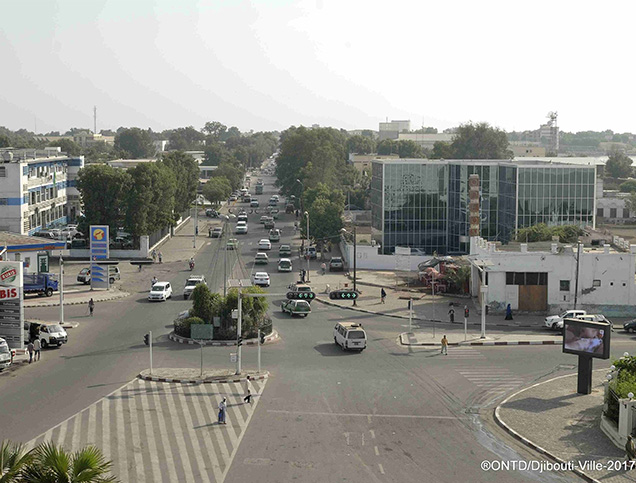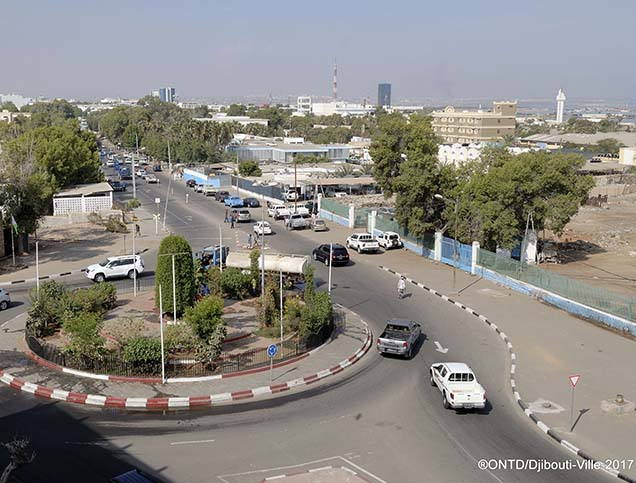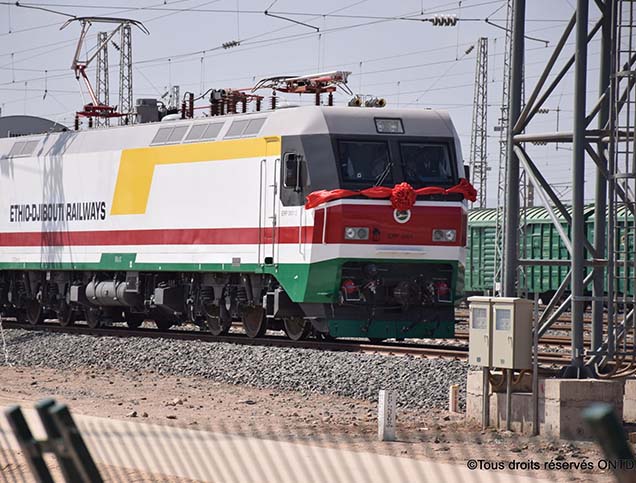
Close

Djibouti, the name by which the city was formerly known, is located in the Horn of Africa on the western shore of the Bab el-Mandeb Strait. It covers an area of 23,200 km2 and is bordered by Eritrea to the north, Ethiopia to the west, and Somalia to the southeast, while it overlooks the Red Sea and the Gulf of Aden to the east. Yemen is located on the opposite side of the Red Sea, with its coast about 20 kilometers away from Djibouti, which gives the city a strategic location at the entrance to the Red Sea and the Bab el-Mandeb. Its geographic location, diverse neighborhoods, and prominent landmarks contribute to its importance as a major regional economic and cultural center.
The City of Djibouti is home to many famous districts, such as Hambali 1 and 2, Ainguela, the First, Second, Fourth, and Seventh districts, the Saudi District, Carton, Wilir, Afani 13, Siesta, Vines, Balbala, Haden, and Bickar 12. These neighborhoods are among the most prominent and important in Djibouti, leading to several important and well-known roads in the city.
As for the landmarks, the City of Djibouti is home to numerous notable features, such as:
• Mahmoud Harbi Square: A central plaza named after a prominent Djiboutian national figure featuring green spaces and a statue.
• The People’s Palace: Located in Al Hadaba district, it is the official residence and workplace of the President of Djibouti.
• Port of Djibouti: One of the busiest ports in East Africa, facilitating trade and commercial exchange with neighboring and other countries.
• Other notable landmarks in the City of Djibouti include Moucha Island, Meskali Island, Lake Assal, Lake Abbe, Ali Sabieh, Arta Coast, Ghoubbet al-Kharab, the Day Forest, and the Hamoudi Mosque.

Title: Map shows the administrative boundary of the city.
Djibouti has a population of approximately one million people, according to the 2023 census. About one-fifth of the population lives below the global poverty line, at around $1.25 per day. Djibouti enjoys a diverse population, with the ethnic composition divided into two main ethnic groups: the Afar and the Somali. Additionally, Yemenis and French Europeans have a significant presence in Djibouti. The official languages in Djibouti are Arabic and French, but Somali is the most widely spoken, followed by the Afar Language.
Djibouti is characterized by rapid population growth, increasing from around 69,589 people in 1955 to approximately 884,017 people in 2018. The ethnic composition consists of 56.2% Somali, 24.2% Afar, 15.6% Arab, and 4.525% Yemeni. The small remaining portion of the population are Ethiopians and French Europeans. Regarding social and economic life, around 76% of the population lives in urban areas, while the rest depend on agriculture and pastoralism. Approximately 40,000 Yemeni refugees reside in Djibouti. The religious composition is 94% Muslim and 6% Christian.
Djibouti is considered a small to medium-sized city with a population of less than 750,000 people. The annual population growth rate in the city is around 2-3%, and in 2022, the annual population growth rate was around 2.5%. The percentage of citizens in Djibouti in 2024 was 75%, and the population is expected to increase by around 600,000 people by the year 2030. The population distribution in the City of Djibouti is relatively balanced between the sexes, with slight differences between males (52%) and females (48%). As for the population distribution by age group for the year 2024, it is as follows:
• 30.5% of the population is under 15 years old.
• Around 63% are under 35 years old.
• Only 6.5% are 55 years old or older.
This demographic profile underscores Djibouti’s young population structure, which can support the city’s future economic and social growth.
The income distribution in Djibouti varies across different social and economic groups. A large portion of the population lives in poverty, especially in informal settlements. Foreigners comprise around 25% of the population, contributing to the city’s cultural diversity and economic dynamism. Salaries can differ across sectors and job levels, covering areas like medicine, engineering, education, translation, and customer service.

Title: The Republican Street.
Source: City of Djibouti.

Title: Tokyo Square.
Source: City of Djibouti.

Title: Djibouti Railways.
Source: City of Djibouti.

Title: Ethio – Djibouti Railways.
Source: City of Djibouti.
The City of Djibouti enjoys a hot and dry desert climate, with the capital being one of the hottest and driest cities in the world. The city’s average temperature ranges between 23 °C in the winter and 42 °C in the summer. Rainfall is sparse and typically falls during November, with an average of only five rainy days per year. Consequently, Djibouti is prone to drought but also experiences sudden flooding due to cyclonic activity in the Indian Ocean. Since 2022, the city has faced environmental challenges from its arid climate and rapid urban expansion. The city’s terrain is generally flat, with gently undulating hills in the surrounding areas.
Djibouti suffers from water scarcity, with only 0.3 cubic kilometers of rainwater making up the total renewable water resources. As of 2023, only 10.12 square kilometers, less than 1% of the country’s land area, are irrigated. Accessing clean water poses a major challenge in Djibouti City, with many residents relying on groundwater sources susceptible to depletion and contamination. To address this issue, the government has invested in desalination plants. Additionally, the availability of green spaces in the city is limited due to the arid environment and rapid urban expansion, yet efforts have been made to create green areas within the city to preserve the urban environment and provide recreational opportunities for residents.
Djibouti has embarked on a journey to prepare its economy and preserve its environmental heritage, as the government has started, in cooperation with international organizations, to implement policies to promote sustainability. The most prominent projects include renewable energy initiatives, such as the Grand Bara Solar PV Project, the Ghoubet Wind Power Station, and integrated water resources management projects to improve water security and combat desertification.
The City of Djibouti faces many economic challenges despite the modest and steady growth in recent years, particularly in creating job opportunities and reducing poverty. The annual population growth rate is around 2.5%, and the unemployment rate exceeds 54%, a major contributor to the spread of poverty.
Djibouti’s Gross Domestic Product (GDP) is $1.459 billion, with an annual per capita GDP of $2,700. The economic growth rate is 5%, while the inflation rate is 2.5%. The country’s external debt is estimated at around $821.6 million.
Among the most prominent economic initiatives and activities in Djibouti are:
• Maritime transport activities: Many landlocked African countries use Djibouti’s transport facilities to export their goods, meaning that transit taxes and port fees make up most government revenues.
• Agriculture: Agriculture accounts for only 3% of the economy’s value, and agricultural production is heavily dependent on imports, with local food meeting around 15% of demand.
• Livestock: Djibouti has 1.186 million head of livestock, with exports to Gulf countries.
• Fisheries: Current fish production is around 2,000 tons per year, while potential resources reach 38,000 metric tons.
• Mineral resources: Mineral resources include salt, gold, gypsum, copper, and iron, with the possibility of oil resources in southeastern Djibouti.
• Tourism: Between 53,000 and 73,000 tourists visit the country annually, with the main destinations being the beaches of the islands in the Gulf of Tadjoura and Bab el-Mandeb.
On the other hand, prominent economic development projects include manufacturing handmade towels, a dairy workshop, an oil workshop, a railway workshop and a pasta workshop.
Since January 2022, Djibouti City has faced significant challenges in the housing sector, particularly a shortage of suitable housing for low-income residents. The total number of dwellings is estimated to be in the tens of thousands, with a substantial portion of residents living in informal settlements. Here, a significant percentage of housing units are rented, reflecting the transient nature of the population and the difficulty in affording home ownership. Additionally, a large part of the city’s residential stock consists of informal or slum housing, which often lacks basic services such as clean water, sanitation, and electricity, endangering residents’ health and safety.
Housing Initiatives and Projects: The government, with support from international organizations, has launched several initiatives to address the housing shortage and improve living conditions. These include providing affordable housing options for low-income families, upgrading informal settlements through infrastructure development, and providing basic services. For instance, the Urban Poverty Reduction Project aims to improve living conditions in informal settlements by developing infrastructure, empowering the local community, and providing essential services.
Prominent Housing Projects:
• The Alhamdani Project includes the “New City” built in the (PK13) district on June 25, 2019, and “City Nassib” established on May 1, 2018, consisting of 100 housing units in Balbala.
• The Ibrahim Said Lootah Project, initiated on June 28, 2010, involved the construction of the corniche in Djibouti City, located on Avenue 13 Street.
Despite continuous efforts, the housing situation in Djibouti remains complex. Sustainable investment and cooperation between government agencies, non-governmental organizations, and the private sector are required to ensure all residents have access to safe and affordable housing.
Despite being a small country, Djibouti is investing significantly in its transportation infrastructure to enhance local and international connectivity. The capital city of Djibouti has a vital road network that includes National Highways 1 and 2, while the city is served by Ambouli International Airport and the Port of Djibouti, which is one of the busiest ports in the region, facilitating trade with neighboring countries and beyond. The modes of transportation in Djibouti include cars, taxis, and small buses that cater to the needs of many residents and tourists, as well as walking, which is the primary mobility mode for short distances. The road infrastructure has been improved, and public transportation options have been expanded to alleviate congestion and enhance mobility within the city.
The prominent transportation projects and strategies in Djibouti include:
• Ethio – Djibouti Railway Line strengthens the connection between the two countries and facilitates trade and economic growth. This line was launched in 2018 and is dedicated to transporting goods and passengers, reducing travel time between the two capitals from 7 days to 10-12 hours.
• The Port of Djibouti: The Port of Djibouti is the country’s primary economic activity. The port’s revenues account for 25% of the state’s resources. The Port of Djibouti is the main maritime gateway for landlocked Ethiopia, which has relied on it for 90% of its overland trade since its independence from Eritrea in 1993. The port was expanded in 2002 with the construction of the Doraleh Oil and Container Terminal.
• Ambouli International Airport: Ambouli International Airport serves the city and connects it to numerous international destinations, while taxis are the primary mode of transportation from the airport to the city downtown.
• The African Development Bank’s 2023-2027 Strategy: This strategy aims to support inclusive growth in Djibouti, focusing on developing the energy and transportation sectors’ basic social and economic infrastructure.
The African Development Bank has also launched a project to study Djibouti City’s urban infrastructure and climate adaptation. This project aims to improve access to resilient infrastructure and basic services.